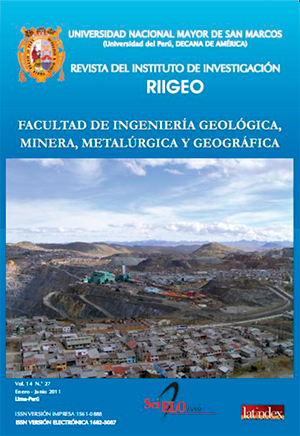Geo-availability of heavy metals in sediments of Supe and Pativilca river, Lima department
DOI:
https://doi.org/10.15381/iigeo.v14i27.762Keywords:
heavy metals, stream sediments, statisticAbstract
This study presents the geochemical-statistical analysis of fourteen heavy metals in active sedimentary of the rivers Supe and Pativilca in which ones prevails the Calipuy and Casma Volcanic lithologies, and in a lower percentage the intrusive lithology of the Cost Batholith. Also the metals that have a normal distribution are Fe in the Pativilca River and Fe-Cr-As-Cu-Hg-Ni-Pb-V-Zn in Supe River. The average abundance shows that Zn and V are the most abundant metals, and Mo, Cd and Hg are showed in small quantities. In the correlation analysis for the Pativilca River, it is showed that the metals that are best correlated are Cd with Mo, Ni, Pb, Zn, which indicates that they all can have the same origin, while in the Supe River the metals have poor correlation which indicates that they do not have the same origin, with the exeption of the Cu with Mo and Fe with V and W. The Principal Component Analysis acknowledged that for the three components of the Pativilca River, the most important association is Cd-Zn-Mo-Ni-Pb- As and for the Supe River is Fe-V-W-Cu. Comparing with the established limits for soils of the Dutch Table, heavy metals in sediments of the Pativilca River only exceeds the limits of intervention in arsenic. Comparing the values of Lima Rivers, both north and south, Rimac River exceeds the intervention values in As, Cu, Zn, Sb; followed by Chillon River in As, Hg, Sb; Lurin River in As, Sb; Mala, Chilca, Chancay, Huara and Pativilca River in As; Omas River in Cu, while Supe River does not have any contamination in its active sediments.Downloads
Published
Issue
Section
License
Copyright (c) 2011 Hugo Rivera, Jorge Chira, Ítalo Medina, André Medina, Irwin Casallo

This work is licensed under a Creative Commons Attribution-NonCommercial-ShareAlike 4.0 International License.
AUTHORS RETAIN THEIR RIGHTS:
a. Authors retain their trade mark rights and patent, and also on any process or procedure described in the article.
b. Authors retain their right to share, copy, distribute, perform and publicly communicate their article (eg, to place their article in an institutional repository or publish it in a book), with an acknowledgment of its initial publication in the Rev. Inst. investig. Fac. minas metal cienc. geogr.
c. Authors retain theirs right to make a subsequent publication of their work, to use the article or any part thereof (eg a compilation of his papers, lecture notes, thesis, or a book), always indicating the source of publication (the originator of the work, journal, volume, number and date).






